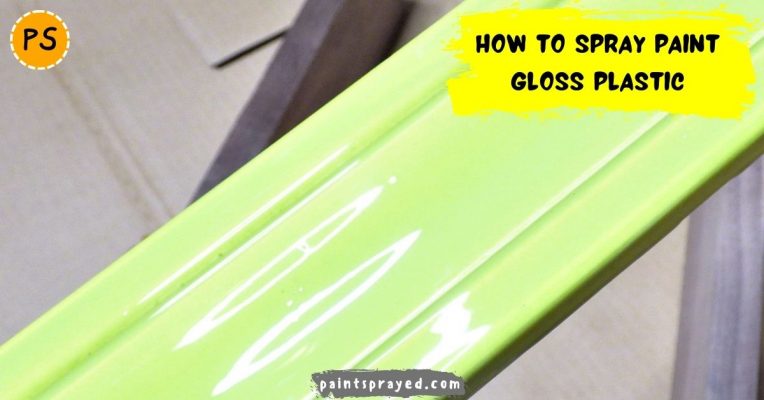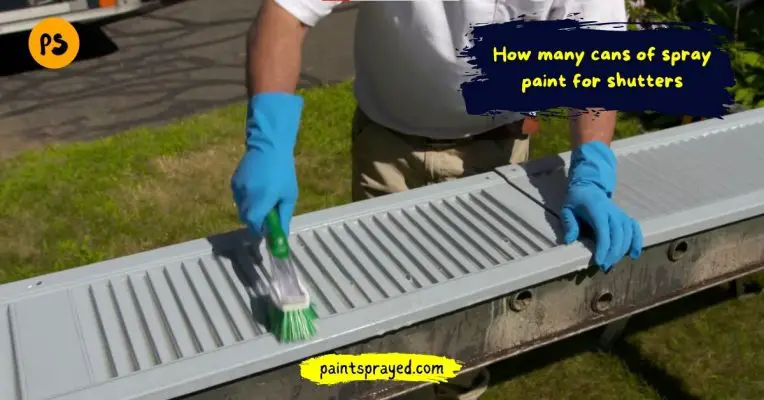Spray painting gloss plastic is an easy and quick process but you have to make sure that you have all the essential things set up before you start spraying.
There are some important steps you have to follow before you start the actual painting process.
These steps will ensure that you don’t make a mess at your home and achieve the desired results you want.
Don’t miss any point if you are an amateur and don’t know how to spray paint gloss plastic because you can damage the plastic surface if you make a single little mistake.
How to spray paint gloss plastic?
Here is a list of some tools you need to spray paint gloss plastic surfaces that are not costly and most of these tools and equipment can be easily found in households.
So, grab these tools and start painting with your desired color.
Below is the list of those tools which you need:
- Bucket for water
- Rags for cleaning
- Scrub brush for cleaning (as needed)
- Spray paint cans
- Dish soap for washing
- Fine sandpaper for sanding purposes
- Mineral spirits or isopropyl alcohol for cleaning
Wear protective gear
Before you start spray painting, it’s important to wear the right protective gear. This includes a respirator, gloves, and goggles.
By doing this, you’ll be protected from harmful fumes and the paint itself.
It’s also a good idea to cover any exposed skin so that you don’t get paint on it. Once you’re all geared up, you can start spray painting.
Remember to work in a well-ventilated area, and to keep the paint can moving so that you don’t get paint buildup.
Select spray paint for gloss plastic
When choosing a spray can for gloss plastic, there are a few things to keep in mind.
First, you’ll want to make sure that the can is compatible with the type of gloss plastic you’re using.
Second, you’ll want to consider the opacity of the paint; if you want a very opaque finish, you’ll need to choose a can with a higher opacity rating.
Finally, you’ll want to think about the paint finish you’re looking for; if you want a high-gloss finish, you’ll need to choose a can with a high-gloss rating.
Clean the plastic surface
Before painting a plastic surface, it is important to clean it with dish soap. This will remove any dirt or grease that may be on the surface and will help the paint to adhere better.
Be sure to rinse the surface well afterward and allow it to dry completely before painting.
Sand the glossy plastic
Before painting any plastic surface, it is important to sand it down with fine sandpaper. This will help to create a smooth surface for the paint to adhere to.
If the surface is not sanded down properly, the paint may not adhere correctly and could end up peeling or chipping off.
Wipe plastic with mineral spirits
Before painting any plastic surface, it is important to wipe it down with mineral spirits.
This will help to remove any dirt or grease that may be on the surface, and will also help to create a smoother surface for the paint to adhere to.
Once the surface is clean and dry, you can then begin to paint.

Apply primer to the plastic surface
It’s important to prime the plastic surface before spray painting, in order to get the best possible finish. Here are the steps to follow:
- Start by cleaning the surface with a mild detergent and water. Allow it to dry completely.
- Next, apply a primer designed for plastic surfaces. You can find these at most hardware stores.
- Once the primer is dry, you’re ready to start spray painting. Be sure to use light, even strokes, and work in a well-ventilated area.
- Allow the paint to dry completely before handling or using the item.
Apply first coat of spray paint
To spray paint a first coat on a plastic surface with a spray can follow these steps:
- Make sure the surface is clean, dry, and free of any debris.
- Prime the surface with a primer designed for plastic surfaces.
- Once the primer is dry, shake the can of spray paint well.
- Hold the can about 10-12 inches from the surface, and begin spraying in a back-and-forth motion.
- Work in thin, even layers until the entire surface is covered.
- Allow the first coat to dry completely before applying a second coat if desired.
Apply the second coat of spray paint
To spray paint a second coat on a plastic surface with a spray can first make sure that the surface is clean and free of any debris.
Next, apply a thin layer of primer to the surface and let it dry.
Once the primer is dry, apply the second coat of paint in long, even strokes. Be sure to overlap each stroke slightly to ensure even coverage.
Let the second coat of paint dry completely before handling the surface.
Can you paint over glossy plastic?
Yes, it is possible to paint over glossy plastic, but it will require some preparation.
The surface of the plastic should be cleaned and roughened with sandpaper to allow the paint to adhere properly.
A plastic primer should also be used before applying the paint.
It’s also important to use paint specifically formulated for plastic, as regular paint may not adhere well or may become brittle over time.
How do you make a glossy finish with spray paint on plastic?
To achieve a glossy finish with spray paint on plastic, you can follow these steps:
- Clean the plastic surface thoroughly to remove any dirt, dust, or oil.
- Sand the plastic surface with fine-grit sandpaper to roughen it and help the paint adhere better. Wipe the surface with a clean rag to remove any dust.
- Apply a plastic primer specifically formulated for use on plastic. This will help the paint adhere better and provide a smooth surface for the topcoat. Allow the primer to dry completely.
- Apply the spray paint in light, even coats, holding the can about 8-10 inches away from the surface and moving in a steady, back-and-forth motion. Allow each coat to dry completely before applying the next.
- After the final coat is dry, you can apply a clear gloss spray sealer to give the surface a glossy finish. Allow it to dry completely.
- Finally, let it cure for 24 hours before handling it.
It is important to use paint specifically formulated for plastic, as regular paint may not adhere well or may become brittle over time.
Also, it’s important to work in a well-ventilated area and follow the manufacturer’s instructions for the primer, paint, and sealer.
What is the best way to spray paint plastic?
The best way to spray paint plastic is to first clean the surface with soap and water, then use a plastic primer specifically designed for plastic surfaces before applying the top coat of spray paint.
It is also important to use paint that is formulated for use on plastic surfaces. It is recommended to use light mist coats and let them dry before applying another coat.
You should avoid using spray paint in humid or windy conditions and always work in a well-ventilated area.
What spray paint will stick to plastic?
There are several types of spray paint that will stick to plastic, but the most effective and durable options are those specifically formulated for use on plastic.
These types of paint typically contain a plasticizer that helps the paint adhere to the plastic surface and resist cracking or peeling over time.
Some brands that make spray paint specifically formulated for plastic include:
- Krylon Fusion for Plastic
- Rust-Oleum Specialty Plastic Spray Paint
- Plasti Dip
- Dupli-Color
- VHT SP229
It’s important to note that to get the best result, it’s important to clean, roughen and prime the plastic surface.
Also, it’s important to follow the manufacturer’s instructions for the primer, paint and sealer.
FAQ’s of how to spray paint gloss plastic
Final thoughts on how to spray paint gloss plastic
In this article, I have told you all the steps you need to know to spray paint gloss plastic and get a paint job that you will be proud to show off.
I hope you found the information helpful. If you have any questions, please leave a comment below or contact me directly in the comments section. I am always happy to help!

Matthew Edward is a professional painter who loves to paint and wants to share useful tips and tricks which he had learned in many years of experience in painting. He also used many products that can be used for painting he has tried and tested each and every product to give an unbias opinion about it in his review. This blog is very useful for those newbies who want to learn painting without making mistakes.






